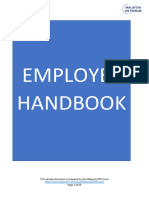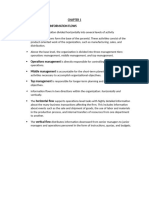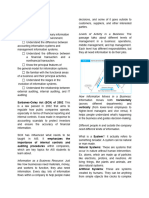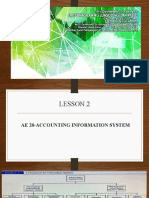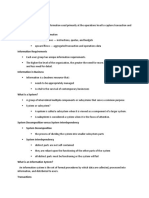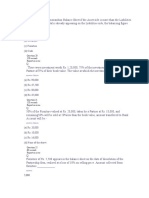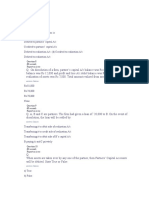0 ratings0% found this document useful (0 votes)
42 viewsAIS Selfmade Chap 1 Reviewer
AIS Selfmade Chap 1 Reviewer
Uploaded by
Jyasmine Aura V. Agustin1) Information is a vital business resource, like capital and labor, that flows both within and outside organizations.
2) Information flows horizontally to support day-to-day operations and vertically from senior to junior managers in the form of instructions.
3) The accounting information system processes financial transactions through subsystems like the transaction processing system and produces financial reports, while the management information system processes non-financial data for decision-making.
Copyright:
© All Rights Reserved
Available Formats
Download as DOCX, PDF, TXT or read online from Scribd
AIS Selfmade Chap 1 Reviewer
AIS Selfmade Chap 1 Reviewer
Uploaded by
Jyasmine Aura V. Agustin0 ratings0% found this document useful (0 votes)
42 views6 pages1) Information is a vital business resource, like capital and labor, that flows both within and outside organizations.
2) Information flows horizontally to support day-to-day operations and vertically from senior to junior managers in the form of instructions.
3) The accounting information system processes financial transactions through subsystems like the transaction processing system and produces financial reports, while the management information system processes non-financial data for decision-making.
Original Title
AIS Selfmade Chap 1 reviewer
Copyright
© © All Rights Reserved
Available Formats
DOCX, PDF, TXT or read online from Scribd
Share this document
Did you find this document useful?
Is this content inappropriate?
1) Information is a vital business resource, like capital and labor, that flows both within and outside organizations.
2) Information flows horizontally to support day-to-day operations and vertically from senior to junior managers in the form of instructions.
3) The accounting information system processes financial transactions through subsystems like the transaction processing system and produces financial reports, while the management information system processes non-financial data for decision-making.
Copyright:
© All Rights Reserved
Available Formats
Download as DOCX, PDF, TXT or read online from Scribd
Download as docx, pdf, or txt
0 ratings0% found this document useful (0 votes)
42 views6 pagesAIS Selfmade Chap 1 Reviewer
AIS Selfmade Chap 1 Reviewer
Uploaded by
Jyasmine Aura V. Agustin1) Information is a vital business resource, like capital and labor, that flows both within and outside organizations.
2) Information flows horizontally to support day-to-day operations and vertically from senior to junior managers in the form of instructions.
3) The accounting information system processes financial transactions through subsystems like the transaction processing system and produces financial reports, while the management information system processes non-financial data for decision-making.
Copyright:
© All Rights Reserved
Available Formats
Download as DOCX, PDF, TXT or read online from Scribd
Download as docx, pdf, or txt
You are on page 1of 6
information is a business resource
Like the other business resources of raw materials,
capital, and labor, information is vital to the survival of
the contemporary business organization.
Information flows out from the organization to external
users, such as customers, suppliers, and stakeholders
who have an interest in the firm.
Business operations form the base of the pyramid.
These activities consist of the product-oriented work of
the organization, such as manufacturing, sales, and
distribution. External users fall into two groups
Above the base level, the organization is divided into Trading partners include customer sales and billing
three management tiers: operations management, information, purchase information for suppliers, and
middle management, and top management. inventory receipts information.
Operations management is directly responsible for Stakeholders are entities outside (or inside) the
controlling day-to-day operations. organization with a direct or indirect interest in the firm.
Stockholders, financial institutions, and government
Middle management is accountable for the short-term
agencies are examples of external stakeholders.
planning and coordination of activities necessary to
accomplish organizational objectives. Stockholders, financial institutions, and government
agencies are examples of external stakeholders.
Top management is responsible for longer-term
Information exchanges with these groups include
planning and setting organizational objectives.
financial statements, tax returns, and stock transaction
Every individual in the organization, from business information.
operations to top management, needs information to
1-1a Information Objectives Three fundamental
accomplish his or her tasks
objectives of Information:
information flows in two direction
To support the firm’s day-to-day operations.
horizontal flow supports operations-level tasks with To support management decision making.
highly detailed information about the many business To support the stewardship function of
transactions affecting the firm. This includes management
information about events such as the sale and shipment
of goods, the use of labor and materials in the System generates mental images of computers and
production process, and internal transfers of resources programming.
from one department to another
System is a group of two or more interrelated
vertical flow distributes information downward from components or subsystems that serve a
senior managers to junior managers and operations common purpose.
personnel in the form of instructions, quotas, and
Some systems are naturally occurring, whereas others
budgets. In addition, summarized information
are artificial
pertaining to operations and other activities flows
upward to managers at all levels.
information system - is the set of formal procedures by Transaction as an event that affects or is of interest to
which data are collected, stored, processed into the organization and is processed by its information
information, and distributed to users. system as a unit of work.
Sales of products to customers, purchases of inventory
from vendors, and cash disbursements and receipts are
Let’s analyze the general definition to gain an examples of financial transactions.
understanding of how it applies to businesses and
information systems. Transactions fall into two classes:
MULTIPLE COMPONENTS. contain more than Financial transactions - is an economic event
one part that affects the assets and equities of the
RELATEDNESS. relates the multiple parts of the organization, is reflected in its accounts, and is
system measured in monetary terms.
SYSTEM VERSUS SUBSYSTEM. these terms are Nonfinancial transactions - are events that do
interchangeable. A system is called a not meet the narrow definition of a financial
subsystem when it is viewed in relation to the transaction.
larger system of which it is a part. Likewise, a
subsystem is called a system when it is the
focus of attention.
PURPOSE. must serve at least one purpose, but
it may serve several.
An automobile is an example of an artificial system that
is familiar to most of us and that satisfies the definition
of a system provided.
Decomposition is the process of dividing the system
into smaller subsystem parts. This is a convenient way
of representing, viewing, and understanding the
relationships among subsystems.
SUBSYSTEM INTERDEPENDENCY- A system’s ability to
achieve its goal depends on the effective functioning
and harmonious interaction of its subsystems. If a vital
subsystem fails or becomes defective and can no longer
meet its specific objective, the overall system will fail to
meet its objective.
Information system is the set of formal procedures by
which data are collected, processed into information,
and distributed to users.
The Accounting Information System
Two broad classes of systems emerge from the
decomposition: * AIS subsystems process financial transactions and
nonfinancial transactions that directly affect the
accounting information system (AIS)
processing of financial transactions.
management information system (MIS)
1. Transaction Processing System (TPS) - is central
to the overall function of the information
The AIS is composed of three major subsystems: system
1. transaction processing system (TPS) - supports - it converts economic events into financial
daily business operations with numerous transactions, records financial transactions in
reports, documents, and messages for users the accounting records (journals and ledgers),
throughout the organization; and distributes essential financial.
2. general ledger/financial reporting system -information to operations personnel to support
(GL/FRS) -produces the traditional financial their daily operations
statements, such as the income statement, - deals with business events that occur
balance sheet, statement of cash flows, tax frequently.
returns, and other reports required by law; and
3. management reporting system (MRS) - TPS is central to the overall function of the
provides internal management with information system by converting economic
specialpurpose financial reports and events into financial transactions, recording
information needed for decision making such as financial transactions in the accounting records
budgets, variance reports, and responsibility (journals and ledgers), and distributing essential
reports. financial information to operations personnel to
The Management Information System- MIS processes support their daily operations.
nonfinancial transactions that are not normally
processed by traditional AIS. TPS consists of three transaction cycles:
expenditure cycle
-Management often requires information that goes conversion cycle
beyond the capability of AIS revenue cycle
2. General Ledger/Financial Reporting Systems
* The GLS and the FRS are two closely related
subsystems. Because of their operational
interdependency, however, they are generally
viewed as a single integrated system—the
GL/FRS.
* The FRS measures the status of financial
resources and the changes in those resources
and communicates this information to external
users
* nondiscretionary reporting - the organization
has few or no choices in the information it
provides.
The Need to Distinguish between AIS and MIS
3. Management Reporting System
*SOX legislation requires that corporate management
* The MRS provides the internal financial information
design and implement internal controls over the entire
needed to manage a business. Typical reports produced
financial reporting process.
by the MRS include budgets, variance reports, cost-
1-1c AIS Subsystems volume-profit analyses, and reports using current
(rather than historical) cost data.
* discretionary reporting because the organization can ► Internal financial transactions involve the exchange
choose what information to report and how to present or movement of resources within the organization.
Data Collection - is the first operational stage in the
information system. The objective is to ensure that
event data entering the system are valid, complete, and
free from material errors.
Two rules govern the design of data collection
procedures:
Relevance
Efficiency
it. Data Processing - group that manages the computer
resources used to perform the day-to-day processing of
End Users
transactions.
Two general groups:
Database Management database - physical repository
External users - include creditors, stockholders, for financial and nonfinancial data.
potential investors, regulatory agencies, tax
The levels in the data hierarchy:
authorities, suppliers, and customers.
Data attribute - is the most elemental piece of
Internal users - include management at all levels of the
potentially useful data in the database. An
organization as well as operations personnel.
attribute is a logical and relevant characteristic
DATA VS INFORMATION of an entity about which the firm captures data.
Record - is a complete set of attributes for a
Data are facts, which may or may not be processed single occurrence within an entity class.
(edited, summarized, or refined) and have no direct file - is a complete set of attributes for a single
effect on a user’s actions. occurrence within an entity class.
Information causes the user to take an action that he or Database Management Tasks
she otherwise could not, or would not, have taken.
Information is often defined simply as processed data. Database management involves three fundamental
tasks: storage, retrieval, and deletion.
** One person’s information is another person’s data.
Thus, information is not just a set of processed facts storage - assigns keys to new records and stores
arranged in a formal report. Information triggers users them in their proper location in the database
to take actions that support their day-to-day business retrieval - the task of locating and extracting an
tasks, resolve conflicts, and plan for the future. existing record from the database for
processing
Data Sources - are financial transactions that enter the deletion - task of permanently removing
information system from either internal or external obsolete or redundant records from the
sources. database.
► External financial transactions are the most Information generation is the process of compiling,
common source of data. These are economic exchanges arranging, formatting, and presenting information
with other business entities and individuals outside the to users. Information can be an operational
firm. document such as a sales order, a structured report,
or a message on a computer screen. Regardless of Information System Objectives Each organization
physical form, useful information has the following must tailor its information system to the needs of
characteristics: relevance, timeliness, accuracy, its users. Therefore, specific information system
completeness, and summarization. objectives may differ from firm to firm. Three
fundamental objectives are, however, common to
RELEVANCE. The contents of a report or document all systems:
must serve a purpose. This could be to support a
manager’s decision or a clerk’s task. We have
established that only data relevant to a user’s action
have information content. 1. To support the stewardship function of
management. Stewardship refers to
management’s responsibility to properly
manage the resources of the firm. The
TIMELINESS. The age of information is a critical information system provides information about
factor in determining its usefulness. Information resource utilization to external users via
must be no older than the time of the action it traditional financial statements and other
supports. mandated reports. Internally, management
receives stewardship information from various
responsibility reports.
ACCURACY. Information must be free from material 2. 2. To support management decision making.
errors. However, materiality is a difficult concept to The information system supplies managers with
quantify. It has no absolute value; it is a problem- the information they need to carry out their
specific concept. This means that, in some cases, decision-making responsibilities.
information must be perfectly accurate. 3. 3. To support the firm’s day-to-day operations.
The information system provides information to
operations personnel to assist them in the
COMPLETENESS. No piece of information essential efficient and effective discharge of their daily
to a decision or task should be missing. For tasks.
example, a report should provide all necessary ACQUISITION OF INFORMATION SYSTEMS
calculations and present its message clearly and (1) they develop customized systems from
unambiguously. scratch through in-house systems development
activities,
(2) they purchase preprogrammed commercial
systems from software vendors.
SUMMARIZATION. Information should be
aggregated in accordance with the user’s needs.
Larger organizations with unique and frequently
Lowerlevel managers tend to need information that
changing needs engage in in-house
is highly detailed.
development. The formal process by which this
is accomplished is called the system
development life cycle. Smaller 14 PART I
Feedback is a form of output that is sent back to the Overview of Accounting Information Systems
system as a source of data. Feedback may be companies and larger firms that have
internal or external and is used to initiate or alter a standardized information needs are the primary
process. market for commercial software.
Turnkey systems are completely finished and
tested systems that are ready for
implementation. Typically, they are general- 1. Geographic Location. Many organizations
purpose systems or systems customized to a have operations dispersed across the
specific industry. country and around the world.
2. 2. Product Line. Companies that produce
Backbone systems consist of a basic system highly diversified products often organize
structure on which to build. The primary around product lines, creating separate
processing logic is preprogrammed, and the divisions for each. Product segmentation
vendor then designs the user interfaces to suit allows the organization to devote
the client’s unique needs. specialized management, labor, and
resources to segments separately, almost as
Vendor-supported systems are custom (or if they were separate firms.
customized) systems that client organizations 3. . Business Function. Functional
purchase commercially rather than develop in- segmentation divides the organization into
house. Under this approach, the software areas of specialized responsibility based on
vendor designs, implements, and maintains the tasks.
system for its client.
Segmentation by business function is the most common
method of organizing. To illustrate it, we will assume a
ORGANIZATIONAL STRUCTURE
The structure of an organization reflects the manufacturing firm that uses these resources:
materials, labor, financial capital, and information.
distribution of responsibility, authority, and
accountability throughout the organization.
These flows are illustrated in Figure 1-7. Firms
achieve their overall objectives by establishing
measurable financial goals for their operational
units. For example, budget information flows
downward. This is the mechanism by which
senior management conveys to their
subordinates the standards against which they
will be measured for the coming period. The
results of the subordinates’ actions, in the form
of performance information, flow upward to
senior management. Understanding the
distribution pattern of responsibility, authority,
and accountability is essential for assessing user
information needs.
BUSINESS SEGMENTS
Firms organize into segments to promote
internal efficiencies through the specialization
of labor and cost-effective resource allocations.
Managers within a segment can focus their
attention on narrow areas of responsibility to
achieve higher levels of operating efficiency.
Three of the most common approaches include
segmentation by:
You might also like
- Employee Handbook Sample Malaysia HR Forum v3Document59 pagesEmployee Handbook Sample Malaysia HR Forum v3mika chu100% (2)
- Management Information systems - MIS: Business strategy books, #4From EverandManagement Information systems - MIS: Business strategy books, #4No ratings yet
- Welding of HY-100Document2 pagesWelding of HY-100nsitvarNo ratings yet
- SASO Standards - Food Packaging ContainersDocument7 pagesSASO Standards - Food Packaging ContainersIrfan chaudharyNo ratings yet
- Blockchain Documentation PDFDocument50 pagesBlockchain Documentation PDFPriyanka Pandey0% (1)
- Chapter 1Document8 pagesChapter 1castrojaniemNo ratings yet
- AIS - Chapter 1Document8 pagesAIS - Chapter 1EllaNo ratings yet
- Chapter 1 Reviewer Ais Chapter 1 Reviewer AisDocument7 pagesChapter 1 Reviewer Ais Chapter 1 Reviewer AisAsh imoNo ratings yet
- Chapter 1Document20 pagesChapter 1Stephanie De LeonNo ratings yet
- Bsa2 1ST Sem - Ac 2104 - NotesDocument43 pagesBsa2 1ST Sem - Ac 2104 - Notesshanehfernandez18No ratings yet
- Acc. Info. System ReviewerDocument13 pagesAcc. Info. System ReviewerchxrlttxNo ratings yet
- The Information System (Chapter 1)Document3 pagesThe Information System (Chapter 1)Mary Claudette UnabiaNo ratings yet
- Accounting Information System ReviewerDocument17 pagesAccounting Information System ReviewerAcain Rolien100% (1)
- AIS Chapter OneDocument8 pagesAIS Chapter Onetarekegn gezahegn100% (1)
- Levels of Activity in A Business: TheDocument5 pagesLevels of Activity in A Business: TheitsyeoboNo ratings yet
- CH1 - The Accounting PerspectiveDocument9 pagesCH1 - The Accounting PerspectiveMina MyouiNo ratings yet
- Four Major Sections: Chapter 1. The Information System: An Accountant's PerspectiveDocument16 pagesFour Major Sections: Chapter 1. The Information System: An Accountant's PerspectiveEden BandiolaNo ratings yet
- Ais ReviewerDocument3 pagesAis ReviewerCutie HimawariNo ratings yet
- Ais 1Document129 pagesAis 1abenezer nardiyasNo ratings yet
- UntitledDocument8 pagesUntitledCyrene CruzNo ratings yet
- The Information System FinalDocument30 pagesThe Information System FinalMarife RomeroNo ratings yet
- AIS ReviewerDocument22 pagesAIS Reviewersky.dumpacc00No ratings yet
- Accounting Information Systems Summary NDocument7 pagesAccounting Information Systems Summary NZOEZEL ANNLEIH LAYONGNo ratings yet
- Chapter 1 PPT (AIS - James Hall)Document5 pagesChapter 1 PPT (AIS - James Hall)Nur-aima MortabaNo ratings yet
- Prelim ReviewerDocument10 pagesPrelim ReviewerEleen Samantha PazNo ratings yet
- The Information SystemDocument10 pagesThe Information SystemABStract001No ratings yet
- Lesson 2 - Ae20Document17 pagesLesson 2 - Ae20Krizza Ann Olivia NavarroNo ratings yet
- ACCTG 203 Prelim Discussion - Introduction To Accounting Information SystemDocument53 pagesACCTG 203 Prelim Discussion - Introduction To Accounting Information SystemRhea BadanaNo ratings yet
- The Information System: An Accountant's PerspectiveDocument19 pagesThe Information System: An Accountant's Perspectivekateangel ellesoNo ratings yet
- An Information Systems FrameworkDocument30 pagesAn Information Systems FrameworkDr. Mohammad Noor AlamNo ratings yet
- Chapter 1 - The Information System: An Accountant's PerspectiveDocument9 pagesChapter 1 - The Information System: An Accountant's PerspectiveKimberly LimNo ratings yet
- AIS Chapter 1Document31 pagesAIS Chapter 1Dr. Mohammad Noor AlamNo ratings yet
- Chapter 1 (The Information Environment)Document13 pagesChapter 1 (The Information Environment)Alyssa BerangberangNo ratings yet
- AC 2104 Chap 1 NotesDocument6 pagesAC 2104 Chap 1 NotessapilanfranceneNo ratings yet
- Ais ReviewerDocument5 pagesAis ReviewerRazel MhinNo ratings yet
- Horizontal Flows of Information Used Primarily at The Operations Level To Capture Transaction andDocument7 pagesHorizontal Flows of Information Used Primarily at The Operations Level To Capture Transaction andcrimsengreenNo ratings yet
- Reviewer AIS Chap 1 and 2Document10 pagesReviewer AIS Chap 1 and 2Jyasmine Aura V. AgustinNo ratings yet
- AIS Chapter-1-ModuleDocument13 pagesAIS Chapter-1-ModuleDeanNo ratings yet
- Ais Chap 1 (Quizlet)Document10 pagesAis Chap 1 (Quizlet)Piolo fuentesNo ratings yet
- Chapter 1Document5 pagesChapter 1Danica GonzalesNo ratings yet
- Audisys 1Document6 pagesAudisys 1Aye ChavezNo ratings yet
- An Information System FrameworkDocument40 pagesAn Information System FrameworkHanabusa Kawaii IdouNo ratings yet
- The Information Environment: Vertical FlowDocument11 pagesThe Information Environment: Vertical FlowPeachyNo ratings yet
- A 20Document4 pagesA 20raevincelleNo ratings yet
- Chapter 1Document8 pagesChapter 1Jolina T. OrongNo ratings yet
- James Hall AisDocument22 pagesJames Hall AisKim Jongdae100% (2)
- AIS Lesson 2Document7 pagesAIS Lesson 2RokrokNo ratings yet
- System: HorizontalDocument5 pagesSystem: HorizontalMa Sonia JorgeNo ratings yet
- Information System: Operational-Level Systems Support Operational Managers by Keeping TrackDocument17 pagesInformation System: Operational-Level Systems Support Operational Managers by Keeping TrackAvreile RabenaNo ratings yet
- AIS Chapter 1Document5 pagesAIS Chapter 1Reyna Marie Labadan-LasacarNo ratings yet
- M1Document14 pagesM1busganonicole554No ratings yet
- Internal Flows of InformationDocument3 pagesInternal Flows of InformationKrisshaNo ratings yet
- ACC 225 Midterm ReviewerDocument12 pagesACC 225 Midterm ReviewerAGUIRRE, Arabella Grace F.No ratings yet
- Chapter OneDocument5 pagesChapter Onefreaann03No ratings yet
- Bsa201 CH01 WRDocument36 pagesBsa201 CH01 WRNicah AcojonNo ratings yet
- AIS Topic 1Document11 pagesAIS Topic 1Liew ZhitangNo ratings yet
- Processing SystemDocument2 pagesProcessing SystemInday MiraNo ratings yet
- Chapter 1 The Information System An AccoDocument4 pagesChapter 1 The Information System An Accoctyre34No ratings yet
- Ais SummaryDocument2 pagesAis Summarylilis eNo ratings yet
- What Is Accounting Information SystemsDocument5 pagesWhat Is Accounting Information SystemsElyssa MendozaNo ratings yet
- The Information System: An Accountant'S PerspectiveDocument5 pagesThe Information System: An Accountant'S PerspectivexxpinkywitchxxNo ratings yet
- AIS NotesDocument13 pagesAIS NotesMad DummyNo ratings yet
- Chapter 1 THE INFORMATION SYSTEM AN ACCOUNTANT'S PERSPECTIVEDocument11 pagesChapter 1 THE INFORMATION SYSTEM AN ACCOUNTANT'S PERSPECTIVEAngela Marie PenarandaNo ratings yet
- Accounting Information System Chapter 1Document28 pagesAccounting Information System Chapter 1Cassie100% (2)
- Is Severance Pay Taxable?: Supreme Court RuledDocument1 pageIs Severance Pay Taxable?: Supreme Court RuledJyasmine Aura V. AgustinNo ratings yet
- Classify Animals According To Their Body Parts. 2. Describe The Functions of Each Body Part of AnimalsDocument3 pagesClassify Animals According To Their Body Parts. 2. Describe The Functions of Each Body Part of AnimalsJyasmine Aura V. AgustinNo ratings yet
- MINI PERFORMANCE TSKDocument5 pagesMINI PERFORMANCE TSKJyasmine Aura V. AgustinNo ratings yet
- What Are The Techniques For Job SimplificationsDocument2 pagesWhat Are The Techniques For Job SimplificationsJyasmine Aura V. AgustinNo ratings yet
- What Are The Four Types of Manufacturing ProcessesDocument1 pageWhat Are The Four Types of Manufacturing ProcessesJyasmine Aura V. AgustinNo ratings yet
- 1 To 111 Thories 1 57Document34 pages1 To 111 Thories 1 57Jyasmine Aura V. AgustinNo ratings yet
- Do You Get Severance If Your Position Is EliminatedDocument3 pagesDo You Get Severance If Your Position Is EliminatedJyasmine Aura V. AgustinNo ratings yet
- How Can We Apply Work Simplification Techniques For Household TasksDocument1 pageHow Can We Apply Work Simplification Techniques For Household TasksJyasmine Aura V. AgustinNo ratings yet
- CHAPTER 8-Revenue Recognition: Construction Contracts Multiple ChoiceDocument5 pagesCHAPTER 8-Revenue Recognition: Construction Contracts Multiple ChoiceJyasmine Aura V. AgustinNo ratings yet
- Educational Technology ChallengesDocument1 pageEducational Technology ChallengesJyasmine Aura V. AgustinNo ratings yet
- The 19th Century World of Jose RizalDocument3 pagesThe 19th Century World of Jose RizalJyasmine Aura V. AgustinNo ratings yet
- Quiz 6Document8 pagesQuiz 6Jyasmine Aura V. AgustinNo ratings yet
- This Study Resource Was: Use The Following Information For Questions 40 To 43Document9 pagesThis Study Resource Was: Use The Following Information For Questions 40 To 43Jyasmine Aura V. AgustinNo ratings yet
- Part 2 Chapter 1Document4 pagesPart 2 Chapter 1Keay ParadoNo ratings yet
- Quiz 8Document3 pagesQuiz 8Jyasmine Aura V. AgustinNo ratings yet
- Quiz 6Document6 pagesQuiz 6Jyasmine Aura V. AgustinNo ratings yet
- Partnership Liquidation: Skip To Main ContentDocument3 pagesPartnership Liquidation: Skip To Main ContentJyasmine Aura V. AgustinNo ratings yet
- Quiz 15Document10 pagesQuiz 15Jyasmine Aura V. AgustinNo ratings yet
- Cost Accounting Chapter 3Document5 pagesCost Accounting Chapter 3Jenefer DianoNo ratings yet
- Scout APM Announces Python Application Support For Error Monitoring ToolDocument3 pagesScout APM Announces Python Application Support For Error Monitoring ToolPR.comNo ratings yet
- 77 Chan Wan V Tan KimDocument14 pages77 Chan Wan V Tan KimPatricia Anne GonzalesNo ratings yet
- Gurukripa's Guideline Answers To Nov 2013 Exam Questions CA Inter (IPC) Group I AccountingDocument14 pagesGurukripa's Guideline Answers To Nov 2013 Exam Questions CA Inter (IPC) Group I AccountingAbhishek ChowdhuryNo ratings yet
- Goods Declaration Revised HitlDocument4 pagesGoods Declaration Revised HitlNdipapeh mamaNo ratings yet
- II. Management AspectDocument6 pagesII. Management AspectJukay H.SocorNo ratings yet
- ABM Module 4Document6 pagesABM Module 4Xyxy LofrancoNo ratings yet
- Ispar 22 09 2010 PDFDocument18 pagesIspar 22 09 2010 PDFKe'nan LundebaNo ratings yet
- FIN 455 Tutorial Session 4Document9 pagesFIN 455 Tutorial Session 4Alix BEDOUINNo ratings yet
- Employment ContractDocument4 pagesEmployment ContractRamesh Kumar a/l Moona Haji Mohamed RajooNo ratings yet
- Company Profile V134Document38 pagesCompany Profile V134ahamedthousifNo ratings yet
- Accruals and PrepaymentsDocument8 pagesAccruals and PrepaymentsShaikh Ghassan AbidNo ratings yet
- Fu Wang Ceramic Debt Management RatioDocument4 pagesFu Wang Ceramic Debt Management RatioMd Abil KhanNo ratings yet
- ELCA Systems - References & ProfileDocument21 pagesELCA Systems - References & ProfileAbhijith shettyNo ratings yet
- WMC CityDevelopmentPlan WalajapetDocument197 pagesWMC CityDevelopmentPlan Walajapetraj kumarNo ratings yet
- A Stud y On Marketing For Entrepreneurs at Red Bull BangaloreDocument102 pagesA Stud y On Marketing For Entrepreneurs at Red Bull BangaloreShraddha Singh100% (1)
- A Study of Inbound Logistics Mode Based On JIT Production in Cruise Ship ConstructionDocument18 pagesA Study of Inbound Logistics Mode Based On JIT Production in Cruise Ship ConstructionSandraNo ratings yet
- Tema 1 - Ingles para Los Negocios IIDocument12 pagesTema 1 - Ingles para Los Negocios IIJayro Corahua AlcantaraNo ratings yet
- 550041813BCom I YearDocument13 pages550041813BCom I Yearwonder netNo ratings yet
- Adjusting Option Trades With Bill LaddDocument3 pagesAdjusting Option Trades With Bill LaddAndrew ChanNo ratings yet
- 2012 Biogen Idec Corporate Citizenship ReportDocument53 pages2012 Biogen Idec Corporate Citizenship ReportManpreet Singh SasanNo ratings yet
- Fidele SlidesCarnivalDocument29 pagesFidele SlidesCarnivalPatricia VenturaNo ratings yet
- SOP For PGS Group CreationDocument6 pagesSOP For PGS Group Creationbaniyakhera fpoNo ratings yet
- BEL Project FinalDocument91 pagesBEL Project FinalCenu Roman100% (1)
- Marketing CalenderDocument6 pagesMarketing CalenderCharan Tej VukantiNo ratings yet
- Entrepreneurship Assignment 1 PDFDocument7 pagesEntrepreneurship Assignment 1 PDFKavin MartinNo ratings yet
